
Transport and Communications Science Journal, Vol 76, Issue 01 (01/2025), 89-101
89
Transport and Communications Science Journal
ACCELERATED CORROSION EFFECTS ON STEEL PIPE PILE
MATERIALS IN SIMULATED NHA TRANG SEAWATER, VIETNAM
Nguyen Thi Tuyet Trinh1*, Le Trung Hieu2
1University of Transport and Communications, No 3 Cau Giay Street, Hanoi, Vietnam
2University of Transport Technology, No 54 Trieu Khuc Street, Hanoi, Vietnam
ARTICLE INFO
TYPE: Research Article
Received: 29/10/2024
Revised: 27/12/2024
Accepted: 10/01/2025
Published online: 15/01/2025
https://doi.org/10.47869/tcsj.76.1.8
*Corresponding author
Email: tuyettrinh@utc.edu.vn
Abstract. Steel pipe piles are widely used in coastal infrastructure due to their high strength
and durability. However, in tropical marine environments like Nha Trang, Vietnam, the high
chloride content, temperature, and humidity significantly accelerate the corrosion process.
Despite their extensive application, no published studies have specifically addressed the
corrosion behavior of steel pipe piles in Vietnam's marine environment. This study
investigated the accelerated corrosion effects on steel pipe pile materials in a simulated Nha
Trang seawater environment, representing typical coastal conditions in Vietnam. Using an
accelerated corrosion testing method, steel pipe pile material samples were exposed to
controlled Nha Trang seawater conditions with varying salinity and environmental factors
such as temperature and pH. The objective of this experiment was to analyze the corrosion
rate and determine the corrosion mechanisms within a short period, simulating long-term
effects typically seen in real seawater environments. The experiment revealed mass loss and
pitting corrosion morphology on SKK490 samples, highlighting the degradation caused by
high chloride content and other conditions in the Nha Trang simulated seawater environment.
The results provide critical insights into the corrosion behavior specific to Nha Trang
seawater environment of Vietnam, particularly regarding the reduction in cross-sectional area
of the steel pile materials. These findings offer valuable guidance for coastal infrastructure
projects, especially in the selection of appropriate materials and the development of effective
corrosion prevention strategies for long-term use in seawater environments.
Keywords: accelerated corrosion testing, steel piles, Nha Trang seawater, corrosion
prevention, comparative analysis.
@ 2025 University of Transport and Communications

Transport and Communications Science Journal, Vol 76, Issue 01 (01/2025), 89-101
90
1. INTRODUCTION
Vietnam, with over 3,260 (km) of coastline and a vast maritime area, has been vigorously
developing marine-based industries, including maritime transportation, coastal infrastructure
construction, and offshore oil and gas exploration projects [1]. Among these, Nha Trang City,
located in Khanh Hoa Province, stands out as a strategic area with several important seaports
and coastal structures. However, the tropical marine environment characteristic of Nha Trang
presents significant challenges for the construction and maintenance of steel structures due to
the effects of corrosion. Factors such as high temperatures, high humidity, and particularly
high chloride content in seawater have been severely impacting the lifespan of steel
structures, including steel piles, which are widely used in port foundation, underground
structures, and other coastal infrastructure [2].
The issue of corrosion in the marine environment not only leads to structural degradation
and safety concerns but also results in high maintenance, repair, and replacement costs [3].
Understanding the corrosion mechanisms and the extent of corrosion affecting steel piles in
the Nha Trang seawater environment is crucial for developing optimal technical solutions to
protect these piles. This study focuses on evaluating the impact of accelerated corrosion
processes on steel pile materials in simulated Nha Trang seawater conditions in the
laboratory. The study aims to recreate the actual conditions of Nha Trang seawater, and
through accelerated corrosion experiments, analyze the degree and morphology of corrosion
of the steel pile materials in Nha Trang seawater.
The goal of the study is to provide a comprehensive understanding of the corrosion levels
of steel pile materials in the Nha Trang seawater environment, thereby offering practical
recommendations to enhance the load-bearing capacity and lifespan of steel piles. This
research is not only crucial for coastal infrastructure development projects in Vietnam but also
contributes to the development of more sustainable design, maintenance, and repair strategies
in harsh marine environments, helping to reduce operational costs and improve long-term
safety.
2. EXPERIMENTS
2.1. Experimental method and applied standards
The corrosion experiment utilizes the Accelerated corrosion testing with impressed
current method. This is an advanced experimental method designed to evaluate the corrosion
rate of metal materials in a controlled environment, commonly used to simulate the harsh
conditions that materials may face in reality [4, 5]. This method uses an impressed current to
accelerate the corrosion reaction, allowing for a quick assessment of the durability and
reliability of materials under various conditions [6].
The electrochemical accelerated corrosion test is conducted based on the following
standards:
ASTM G31 - Standard Guide for Laboratory Immersion Corrosion Testing of Metals [7]:
This standard is applied to determine the sample size, immersion procedure, and duration of
the immersion test for steel samples in simulated Vietnamese seawater.
ASTM G102 - Standard Practice for Calculation of Corrosion Rates and Related
Information from Electrochemical Measurements [8]: This standard is applied to calculate
parameters such as the impressed current applied to the test samples in the experiment.

Transport and Communications Science Journal, Vol 76, Issue 01 (01/2025), 89-101
91
ASTM G5 - Standard Reference Test Method for Making Potentiostatic and
Potentiodynamic Anodic Polarization Measurements [9] : This standard is applied to set up
the applied electrode system and reference electrodes in the experimental setup for the study.
2.2. Sample design
SKK490 is a commonly used steel type for many coastal constructions in Vietnam due to
its advantages in structure and technical characteristics, such as at Dung Quat Port (Quang
Ngai), Son Duong Port (Ha Tinh), and others. Therefore, the study selects SKK490 steel for
corrosion experiment. SKK490 is a high-strength structural pipe steel according to JIS A5525
standards, with good mechanical properties and a tensile strength of approximately 490 - 610
(Mpa) [10]. The test results of the main chemical composition and mechanical strength of
SKK490 steel are presented in Table 1 and Table 2.
Table 1. Test results of the main chemical composition of SKK490 steel.
Composition
SKK490 steel
Carbon (C)
0.17 (%)
Silicon (Si)
0.30 (%)
Manganese (Mn)
1.40 (%)
Phosphorus (P)
0.035 (%)
Sulfur (S)
0.03 (%)
Niobium (Nb)
-
Vanadium (V)
-
Titanium (Ti)
-
Table 2. Test results of the mechanical strength of SKK490 steel.
Composition
SKK490 steel
Yield strength (MPa)
325
Tensile strength (MPa)
510
Elongation (%)
17 (%)
The typical thickness of large-diameter steel pipe piles in coastal structures ranges from 12 (mm)
to 16 (mm) to ensure load-bearing capacity. Therefore, this study selects three sample thicknesses: 12
(mm), 14 (mm), and 16 (mm), with uniform dimensions (20×200 (mm)). The test samples are cleaned
with a solvent to remove dust, grease, and other contaminants, then rinsed with distilled water and
dried at room temperature.
Table 3. Sample labeling for the experiment
Composition
Dimensions (mm)
Thickness (mm)
Sample Code
SKK490 bare steel
20×200
12
SKK490 - 12
20×200
14
SKK490 - 14
20×200
16
SKK490 - 16
2.3. Design of the simulated solution according to Nha Trang seawater conditions
According to data collected by a group of scientists from the Vietnam Institute of Marine
Resources and Environment, the seawater temperature measured in Nha Trang Bay ranges

Transport and Communications Science Journal, Vol 76, Issue 01 (01/2025), 89-101
92
from 24.7 (°C) to 32.9 (°C). Meanwhile, the seawater pH fluctuates significantly, ranging
from 7.82 to 8.36, with an average of 8.1. The average salinity across the observations is
30‰, indicating the characteristics of salty seawater. The turbidity of seawater in Nha Trang
Bay is relatively low, ranging from 1.0 to 3.3 (NTU), with an average value of 1.40 (NTU),
which is considered favorable for coral reef development [11]. To ensure the simulation of the
Nha Trang seawater environment, the pH of the experimental solution is set at 8.18,
corresponding to the average value.
The seawater in the Nha Trang area has characteristics as shown in Table 4.
Table 4. Seawater characteristics of the Nha Trang are [12].
Chemical composition
Unit
Range
Concentration
CL-
mg/l
Max
19702
Min
19525
SO42-
mg/l
Max
25147
Min
2501
Na+
mg/l
Max
9957
Min
9926
Mg2+
mg/l
Max
1200
Min
1000
Ca2+
mg/l
Max
65.6
Min
24.4
K+
mg/l
Max
680
Min
-
The high concentration of Cl⁻ ions in seawater is a key factor driving the corrosion
process of metals. Cl⁻ ions participate in the mechanism of breaking down the protective
oxide layer on the metal surface, leading to electrochemical attack and localized corrosion,
especially in metals like stainless steel. In the case of Nha Trang seawater, the measured Cl⁻
ion concentration is 19702 (mg/L), corresponding to a molar concentration of approximately
0.556 (mol/L). This concentration reflects the high Cl⁻ ion content in seawater, which plays a
crucial role in determining salinity and other physicochemical properties.
To prepare the experimental solution with a pH of 8.18 and a Cl⁻ ion concentration of
19702 (mg/L), specific adjustments need to be made for both pH and Cl⁻ ion concentration
2.3.1. Adjustment of Cl⁻ ion concentration
Calculating the required amount of NaCl: The concentration of Cl⁻ ions is provided by
sodium chloride (NaCl), where 1 mol of NaCl yields 1 mol of Cl⁻ ions. The molecular weight
of NaCl is 58.44 (g/mol), and Cl⁻ accounts for 35.45 (g/mol) of this. The formula to calculate
the required amount of NaCl to achieve the desired Cl⁻ ion concentration in the solution is
based on the basic principles of quantitative chemistry and concentration calculations. The
steps to perform the calculation are as follows:
- Basic principle:

Transport and Communications Science Journal, Vol 76, Issue 01 (01/2025), 89-101
93
The relationship between concentration and mass: For a simple salt like sodium chloride
(NaCl), when dissolved in water, it fully dissociates into ions:
NaCl → Na++ Cl−
Using molecular weight (mol): The molecular weight of NaCl is 58.44 (g/mol), meaning
1 (mol) of NaCl contains 58.44 (g) of NaCl. Out of this, Cl⁻ accounts for 35.45 (g/mol) of the
total mass. This means that in 1 (mol) of NaCl, there are 35.45 (g) of Cl⁻ ions.
Mass ratio between NaCl and Cl⁻: From the molecular weight of NaCl and Cl⁻, the
amount of NaCl needed to achieve the desired concentration of Cl⁻ ions can be calculated.
This ratio is calculated as follows:
(1)
- Calculating the required mass of NaCl:
Given that the desired Cl⁻ ion concentration is 19702 (mg/L), the necessary NaCl
concentration for the test solution can be calculated using the formula:
NaCl concentration = (g/l)
(2)
Therefore, to achieve a Cl⁻ ion concentration of 19702 (mg/L), 32.48 (g) of NaCl needs
to be dissolved per liter of water.
2.3.2. Preparation of the test solution
To prepare the test solution with a pH of 8.18 and a Cl⁻ ion concentration of 19702
(mg/L), the test solution is made by mixing 1 (litter) of purified water, 32.48 (g) of NaCl, and
a necessary amount of buffering additive to neutralize the solution as follows:
- Basic principle:
Sodium bicarbonate (NaHCO₃) is a commonly used buffering additive in the preparation
of test solutions in Vietnam. When dissolved in water, it dissociates into the following ions:
NaHCO3 → Na+ +
↔ H+ +
To determine the required amount of NaHCO₃ for the test solution, the Henderson-
Hasselbalch equation is used. This equation is applied to calculate the pH of buffer solutions
in particular, and weak acid solutions in general, based on the concentration ratio of their
components [13]:
(3)
Where:
Ka is the acid dissociation constant.



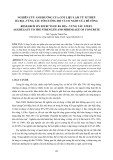
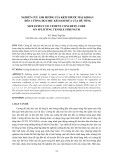
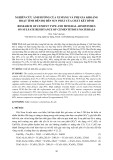
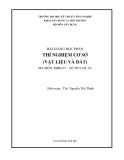



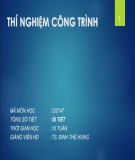

![Bài giảng Quản lý vận hành và bảo trì công trình xây dựng [chuẩn nhất]](https://cdn.tailieu.vn/images/document/thumbnail/2025/20251006/agonars97/135x160/30881759736164.jpg)









![Ngân hàng câu hỏi trắc nghiệm Sức bền vật liệu 1: [Mô tả/Định tính Thêm để Tăng CTR]](https://cdn.tailieu.vn/images/document/thumbnail/2025/20250920/kimphuong1001/135x160/6851758357416.jpg)


![Trắc nghiệm Kinh tế xây dựng [chuẩn nhất]](https://cdn.tailieu.vn/images/document/thumbnail/2025/20250920/kimphuong1001/135x160/32781758338877.jpg)
